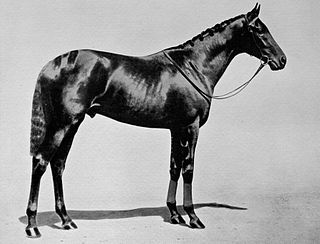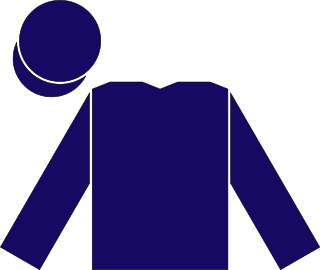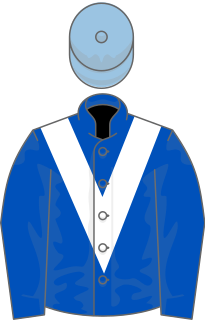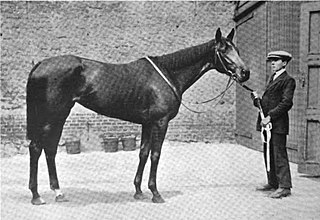Related Research Articles

Solario (1922–1945) was a successful British Thoroughbred racehorse and influential sire.
Never Too Late was an American-bred, French-trained Thoroughbred racehorse. In a racing career lasting from August 1959 until October 1960, the filly ran nine times and won four races. As a two-year-old she proved herself capable of competing against the leading French colts by winning the Prix de la Salamandre at Longchamp and being narrowly beaten in the Grand Critérium. In the following year she was sent to Britain where she won the 1000 Guineas at Newmarket and Oaks at Epsom. She was then retired to stud at the end of her three-year-old season, and had some success as a broodmare.
Shadayid was an American-bred, British-trained Thoroughbred racehorse and broodmare. In a racing career which lasted from June 1990 to November 1991 she ran eleven times winning five races and being placed five times. Shadayid was one of the leading two-year-old fillies in Europe in 1990, winning all three of her races including the Group One Prix Marcel Boussac at the Longchamp. After winning the Fred Darling Stakes on her three-year-old debut, Shadayid took her unbeaten run to five by winning the Classic 1000 Guineas at Newmarket. Although she never won again, she finished second in the Coronation Stakes and the Sussex Stakes and third in the Haydock Sprint Cup and the Queen Elizabeth II Stakes. Shadayid was retired from racing to become a broodmare at the end of her three-year-old season after finishing seventh in the Breeders' Cup Mile.

Salsabil was an Irish-bred, British-trained Thoroughbred racehorse and broodmare. In a racing career which lasted from September 1989 to October 1990 she ran nine times and won seven races. Salsabil was one of the leading two-year-old fillies in Europe in 1989, winning two races including the Group One Prix Marcel Boussac at the Longchamp. After winning the Fred Darling Stakes on her three-year-old debut, Salsabil won both of Britain's Classic races for fillies: the 1000 Guineas over one mile at Newmarket and the Oaks over one and a half miles at Epsom. She was then raced against colts and became the first filly for ninety years to win the Irish Derby at the Curragh. In autumn, Salsabil added a victory in the Prix Vermeille at Longchamp but finished unplaced when favourite for the Prix de l'Arc de Triomphe in October. Salsabil was then retired to stud where she had success as a broodmare before dying of cancer in 1996.

Imagine was an Irish Thoroughbred racehorse and broodmare best known for winning the Irish 1000 Guineas and The Oaks in 2001. In a racing career which lasted from August 2000 to June 2001 the filly ran ten times and won four races. As a two-year-old, Imagine ran six times, winning the Group Three C. L. Weld Park Stakes at the Curragh and finishing second in the Group Two Rockfel Stakes at Newmarket. The following spring, the filly was beaten in her first two races before winning the Irish 1000 Guineas at the Curragh. Imagine recorded her most valuable success on her final appearance, winning the Classic Oaks over one and a half miles at Epsom. She never raced again, but proved to be a successful broodmare.

Moonshell was an Irish-bred Thoroughbred racehorse and broodmare best known for winning The Oaks in 1995. In a racing career which lasted from October 1994 to May 1996, the filly ran five times and won two races. After winning her only race as a two-year-old, Moonshell joined the Godolphin Racing team and spent the winter in Dubai. In the spring of 2005, she returned to England to finish third in the 1000 Guineas at Newmarket and then won the Classic Oaks over one and a half miles at Epsom. Moonshell did not run again as a three-year-old and was well beaten in two races in 1996 before being retired to stud.
Festoon (1951–1973) was a British Thoroughbred racehorse and broodmare, best known for winning the 1000 Guineas in 1954 and setting a world record when being sold at auction later that year. In a racing career which lasted from autumn 1953 to July 1954 the filly ran seven times and won three races. After winning her only race as a two-year-old, Festoon won the Classic 1000 Guineas over one mile at Newmarket Racecourse the following spring. She failed to stay the distance in The Oaks but returned to one mile to win the Coronation Stakes at Royal Ascot and finish third against colts in the Sussex Stakes at Goodwood. She was then retired to stud where she produced several winners.

Rockfel was a British Thoroughbred racehorse and broodmare, best known for winning two Classics in 1938. In a career which lasted from July 1937 until May 1939 she ran thirteen times and won eight races. Rockfel began her career at the lowest level, being beaten in a selling race, but improved to become recognised as one of the best British racemares of the 20th century. In 1938 she was the dominant three-year-old in England, winning the 1000 Guineas over one mile at Newmarket and the Oaks over one and a half miles at Epsom. In the autumn she defeated colts in the Champion Stakes and the Aintree Derby and was retired after winning her only race as a four-year-old. She produced one foal before dying in November 1941.
Galatea was a French-bred, British-trained Thoroughbred racehorse and broodmare, best known for winning two Classics in 1939. The filly won three times from six races in a racing career which lasted from 1938 until June 1939. After failing to win as a two-year-old she won her first three races of 1939 including the 1000 Guineas over one mile at Newmarket and The Oaks over one and a half miles at Epsom Downs Racecourse a month later. She was beaten in her only subsequent race and was retired to stud, where she had some success as a broodmare.
Saucy Sue was a British Thoroughbred racehorse and broodmare, best known for winning two Classics in 1925. The filly won eight times from ten races in a racing career which lasted from July 1924 until October 1925. She was the top-rated British two-year-old of either sex in 1924, when she was unbeaten in three races. In her first two races the following year she won the 1000 Guineas over one mile at Newmarket and The Oaks over one and a half miles at Epsom Downs Racecourse a month later. Saucy Sue took her unbeaten run to seven by winning the Coronation Stakes at Royal Ascot and the Nassau Stakes at Goodwood. She was defeated in her next two races and was retired from racing at the end of the season after a final win in the Atalanta Stakes at Sandown Park.
Oriana was a British Thoroughbred racehorse and broodmare who won the classic Oaks Stakes at Epsom Downs Racecourse in 1810. The Northern-trained filly won the Oaks on her first appearance and finished third against colts in the St Leger Stakes at Doncaster in her only other race that year. She won one of her three races in 1811 and was later exported to become a broodmare in Ireland.
Lovely Rosa was an Irish-bred, British-trained Thoroughbred racehorse and broodmare best known for her win in the 1936 Epsom Oaks. As a juvenile in 1945 she showed some promise when finishing second in the Queen Mary Stakes and winning a race at Newbury but then showed little worthwhile form until her 33/1 upset victory in the Oaks. She never won again and was retired at the end of 1936. She had some success as a broodmare, most notably being the grand-dam of Wilwyn.
Udaipur was a British Thoroughbred racehorse and broodmare. Her racing career consisted of eight races between April and October 1932. Having finished second on her debut and seventh in the 1000 Guineas she was still a maiden when she recorded her biggest win in the Epsom Oaks in June. She went on to win the Coronation Stakes, Richemont Stakes and Newmarket Oaks as well as finishing fourth in a strong edition of the St Leger. As a broodmare she produced several good winners and was the female-line ancestor of Wild Again.

Straitlace was a British Thoroughbred racehorse and broodmare. As a two-year-old she was one of the best fillies of her generation in England when she won five of her eight races. In the following year she finished third in the 1000 Guineas before going on to win the Epsom Oaks, Coronation Stakes and Nassau Stakes, as well as three other races. She earned more money than any other horse in Britain in 1924 and was retired after winning eight of her sister races. Straitlace was exported to France in 1925 and became a very successful and influential broodmare.
Brownhylda was a British Thoroughbred racehorse and broodmare. She showed considerable promise as a two-year-old when she won three times and finished twice on two occasions. In the following year he won the Epsom Oaks and the Park Hill Stakes as well as finishing second in the Yorkshire Oaks. Her form declined thereafter and she failed to win again before being retired at the end of the following year. She produced only four known foals, but these did include the St Leger winner Firdaussi.

Princess Dorrie was a British Thoroughbred racehorse and broodmare. As a two-year-old in 1913 she failed to win a race but was very consistent, finishing placed in seven of her eight starts. In the following year she was probably the best three-year-old filly in England, winning both the 1000 Guineas and the Epsom Oaks. She was retired at the end of the 1914 season and had modest success as a broodmare.
Tide-way was a British Thoroughbred racehorse and broodmare. She was rated one of the best British two-year-old fillies of 1935 when she won twice from four starts. She won the 1000 Guineas on her debut as a three-year-old but finished unplaced in the Epsom Oaks and never ran again. As a broodmare she produced the Eclipse Stakes winner Gulf Stream.
Campanula was a British Thoroughbred racehorse and broodmare. In 1933 she won two of her five races including the Windsor Castle Stakes and the Moulton Stakes and was rated the best juvenile filly in England. In the following spring she won the Column Produce Stakes and then recorded her biggest win in the 1000 Guineas. In her two subsequent races she finished fourth in the Epsom Oaks and second in the Champion Stakes. As a broodmare she exerted an enduring influence as a broodmare through her daughter Calluna.
Cinna was a British Thoroughbred racehorse and broodmare. She showed great promise as a juvenile in 1919 when she won a very competitive maiden race on her debut before finishing second in the New Stakes and the Bretby Stakes. As a three-year-old she won the 1000 Guineas and the Coronation Stakes and was narrowly beaten when favourite for the Epsom Oaks. She was retired from racing at the end of the year and went on to be a very successful broodmare. Three of her sons became leading sires in Australasia whilst several of her daughters became influential broodmares including the female-line ancestors of Sunday Silence and Indian Ridge.
Mesa (1932–1941) was a French Thoroughbred racehorse and broodmare. She showed very good form as a juvenile when she won two races and finished third in the Grand Critérium. In the following year she was sent to England where she won the 1000 Guineas and looked unlucky when finishing third in Epsom Oaks. She also finished second in the Prix du Président de la République and the Prix de La Jonchere and ran fifth in the Grand Prix de Paris. She made a very promising start to her time as a broodmare before dying at the age of nine.
References
- 1 2 "THOUSAND GUINEAS". Evening Post. 1 May 1937. Retrieved 2012-08-30.
- ↑ "CHAMPION SIRES". Evening Post. 18 August 1937. Retrieved 2012-08-30.
- ↑ "Leading Sires of Great Britain and Ireland". Tbheritage.com. Retrieved 2012-08-30.
- 1 2 Mortimer, Roger; Onslow, Richard; Willett, Peter (1999). Biographical Encyclopedia of British Flat Racing. Macdonald and Jane’s. ISBN 0-354-08536-0.
- ↑ "Person Profile : Joseph Lawson". Horseracing History Online. Retrieved 2012-08-28.
- ↑ "ENGLISH TURF". Auckland Star. 5 June 1937. Retrieved 2012-08-30.
- 1 2 ""COME ON, STEVE!" DONOGHUE'S LAST BIG RACE WIN?". Cairns Post. 7 Jun 1937. Retrieved 2012-08-30.
- ↑ "SOLARIO'S FIRST". Evening Post. 3 June 1937. Retrieved 2012-08-30.
- 1 2 ""CERTAINTY" FAILS". Evening Post. 20 May 1937. Retrieved 2012-08-30.
- ↑ "FILLIES' CLASSIC". Evening Post. 5 June 1937. Retrieved 2012-08-30.
- ↑ "SOLARIO'S DOUBLE". Evening Post. 2 July 1937. Retrieved 2012-08-30.
- ↑ Morris, Tony; Randall, John (1999). A Century of Champions. Portway Press. ISBN 1-901570-15-0.
- ↑ "REMARKABLE SALES". Auckland Star. 8 December 1944. Retrieved 2012-08-30.
- ↑ "Exhibitionnist". equineline.com. 2012-05-08. Retrieved 2012-08-30.
- ↑ "Regulus Mare - Family 8-a". Bloodlines.net. Retrieved 2012-08-30.